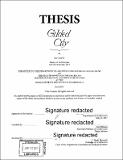| dc.contributor.advisor | Ana Miljacki. | en_US |
| dc.contributor.author | Casimir, Jan | en_US |
| dc.contributor.other | Massachusetts Institute of Technology. Department of Architecture. | en_US |
| dc.date.accessioned | 2017-09-15T15:38:38Z | |
| dc.date.available | 2017-09-15T15:38:38Z | |
| dc.date.issued | 2017 | en_US |
| dc.identifier.uri | http://hdl.handle.net/1721.1/111539 | |
| dc.description | Thesis: S.M. in Architecture Studies, Massachusetts Institute of Technology, Department of Architecture, 2017. | en_US |
| dc.description | Cataloged from PDF version of thesis. "June 2017." | en_US |
| dc.description.abstract | Gilded City appropriates seven copperplate etchings produced by Alexander Brodsky and Ilya Utkin between 1982 and 1990 in the pursuit of their preservation through reinterpretation and recontextualisation. Gilded City reacts to the political events in the United States of the past six months. Gilded City explores the potential of architectural animation as a tool for both design and representation as well as a powerful tool for (anti) propaganda while making use of traditional cel animation, 2D Vector based animation, 3D computer animation as well as motion graphics. In 1978, disenchanted with the bleak prospect of the faceless, unadorned, utilitarian architectural doctrine of the Brezhnev and Khrushchev years, Brodsky and Utkin began to produce fantastical landscapes and structures in exquisite and detailed drawings. Imaginative, light-hearted, subversive, their body of work freely referenced historical precedents ranging from Greek Mythology to 18th Century architects. Brodsky and Utkin utilized paper architecture to subvert the requirements of soviet ideology by inventing a form antithetical to existing power structures. In a similar act of subversion, Gilded City reinterprets this paper architecture in the form of architectural animation, a form that often seems to lack a critical dimension seeking to actively comment on current state of affairs in the North American context. It develops five distinct archetypes each constituting one chapter of the "Gilded City": Tower, Golf Course, Wall, Casino, and Prison. This thesis stakes a claim for the timely relevance of Utkin and Brodsky's body of work to contemporary architectural and socio-political discourse while also arguing for the legitimacy of animation in architectural design. Furthermore, Gilded City also speculates that architectural animation will soon occupy a more significant role both in architectural practice as well as in architectural pedagogy. | en_US |
| dc.description.statementofresponsibility | by Jan Casimir. | en_US |
| dc.format.extent | 131, 1 unnumbered pages | en_US |
| dc.language.iso | eng | en_US |
| dc.publisher | Massachusetts Institute of Technology | en_US |
| dc.rights | MIT theses are protected by copyright. They may be viewed, downloaded, or printed from this source but further reproduction or distribution in any format is prohibited without written permission. | en_US |
| dc.rights.uri | http://dspace.mit.edu/handle/1721.1/7582 | en_US |
| dc.subject | Architecture. | en_US |
| dc.title | Gilded City | en_US |
| dc.type | Thesis | en_US |
| dc.description.degree | S.M. in Architecture Studies | en_US |
| dc.contributor.department | Massachusetts Institute of Technology. Department of Architecture | |
| dc.identifier.oclc | 1003489202 | en_US |
